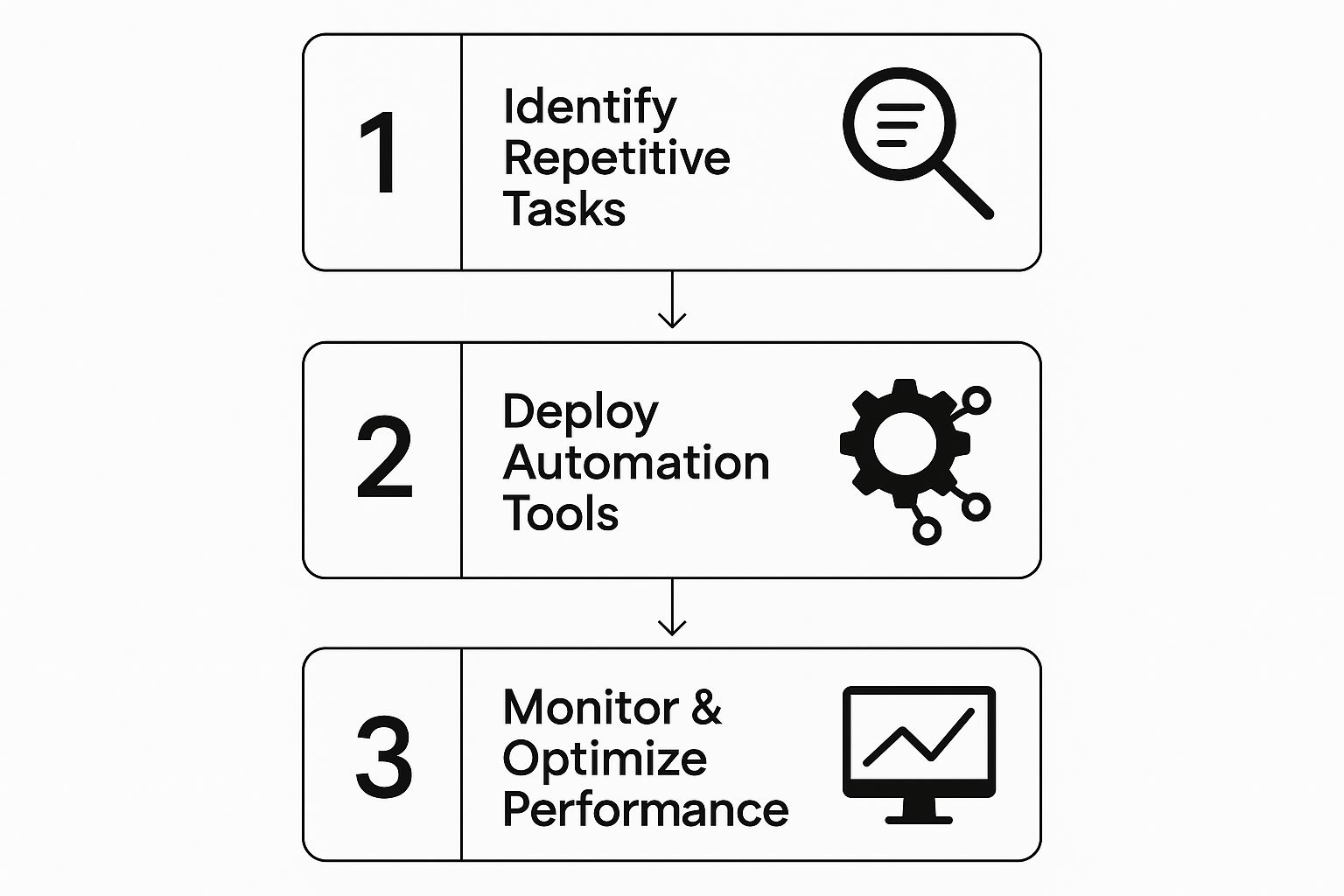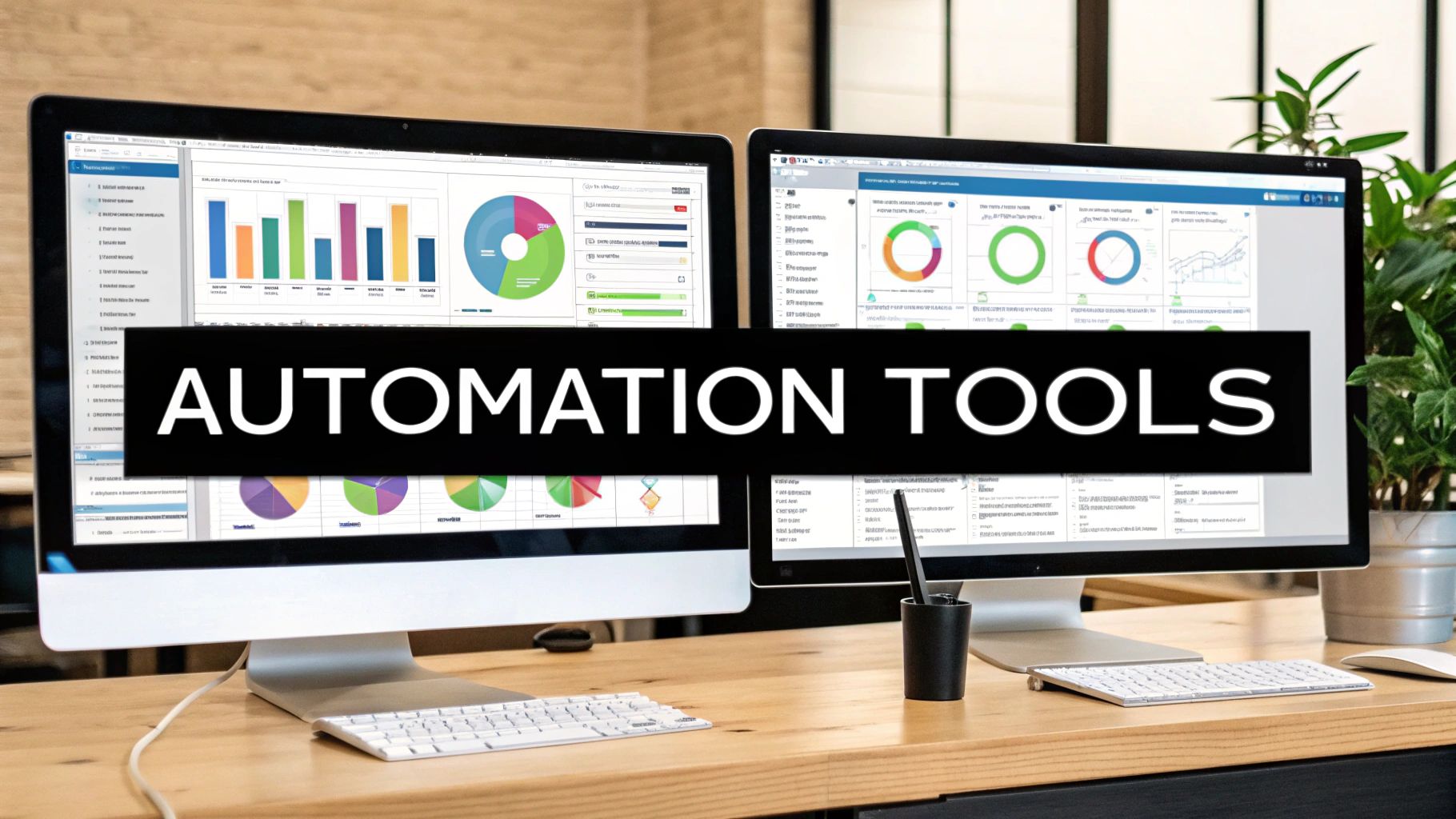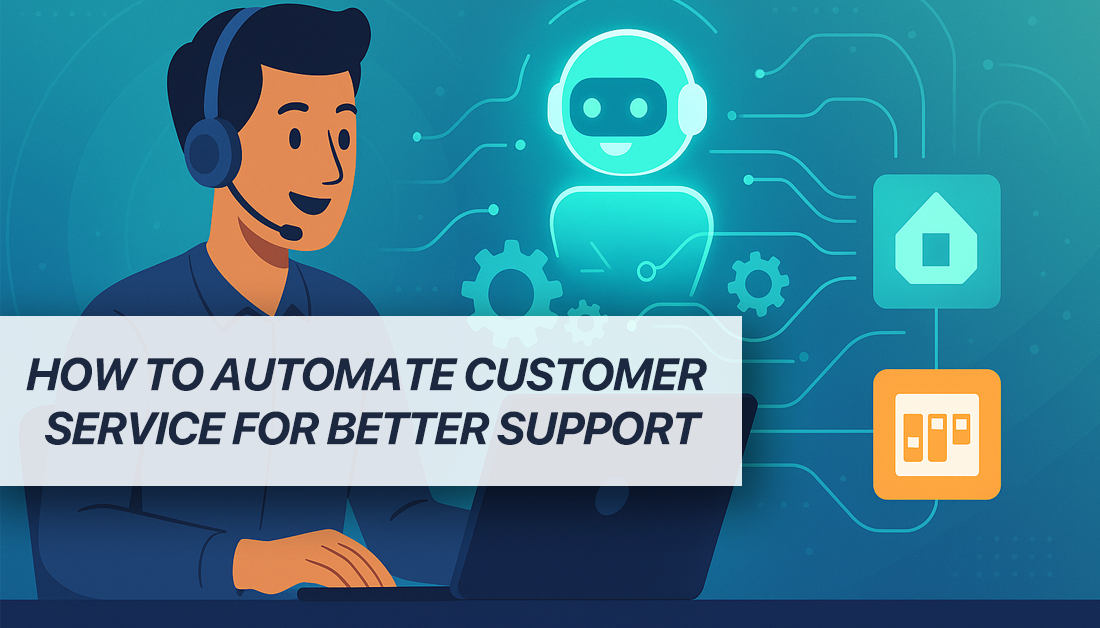Why Automating Customer Service Is No Longer Optional
Customers today expect immediate support. They want quick answers and effective solutions, and anything less can lead to dissatisfaction and, eventually, lost business. This puts tremendous pressure on support teams, who are often overwhelmed with repetitive questions and struggling to keep pace. So how can businesses meet these growing expectations without overburdening their support staff? The answer lies in strategic customer service automation.
Automating routine tasks, such as answering frequently asked questions, resetting passwords, and providing order updates, frees up valuable time for human agents. This allows them to focus on more complex issues requiring empathy, critical thinking, and personalized support. Furthermore, automation ensures consistent responses and 24/7 availability, both of which are crucial to improving the overall customer experience. This means businesses can offer better service while simultaneously boosting operational efficiency.
This shift from reactive to proactive support is no longer a nice-to-have, but a necessity. By strategically automating customer service, companies can cut operational costs and boost customer satisfaction. In fact, by 2025, AI-powered automation is expected to reshape customer service operations, potentially reducing operational expenses by up to 30%. This cost reduction stems from automating repetitive tasks, allowing human agents to handle more complicated issues. Find more detailed statistics here.
The Benefits of Automation Extend Beyond Cost Savings
Automating customer service also brings significant improvements to important performance indicators. Faster response times result in greater customer satisfaction and improved resolution rates. This leads to higher customer retention and, ultimately, improved profits. For businesses using HubSpot and Jira, connecting these platforms is fundamental to achieving these benefits. If you’re building a knowledge base to support customer service, you might find WordPress helpful.
Creating a Connected Ecosystem for Customer Service
Integrating HubSpot, your customer relationship management (CRM) platform, with Jira, your development workflow tool, creates a powerful synergy. This integration ensures that all customer interactions, from the first point of contact to final resolution, are tracked and managed effectively. Automating this flow of information between the two systems eliminates manual data entry and makes sure everyone has access to the latest information. This results in a more streamlined and cohesive customer service experience that benefits both the customer and your team.
The Roadblocks to Seamless Customer Service Automation

While automating customer service offers clear advantages, many organizations face significant challenges. This is especially true for those using both HubSpot and Jira. These roadblocks often arise from the disconnect between customer-facing platforms like HubSpot and the technical workflows in Jira needed to resolve issues. This gap creates several challenges that negatively impact both customer satisfaction and team productivity.
Fragmented Data Creates Blind Spots
One of the most common roadblocks is fragmented customer data. Support teams using HubSpot often lack visibility into the technical aspects of issues being handled in Jira. This creates information silos, forcing support agents to constantly switch between systems to understand the full customer context. This constant context-switching significantly reduces productivity and increases the risk of errors.
Context Switching Drains Productivity
Imagine a customer reporting a bug through HubSpot. The support team logs the issue, but then has to manually create a corresponding ticket in Jira for the development team. This duplication of effort wastes valuable time and increases the chance of information getting lost during the handoff.
Disconnects Impact Resolution Times
Another significant challenge is the lack of automated updates between the systems. Updates from the development team in Jira don’t automatically flow back to HubSpot. This forces support agents to actively pursue updates, delaying resolutions and leading to frustrated customers. This lack of seamless communication between HubSpot and Jira directly impacts resolution times and hinders proactive customer service. Customer expectations are changing, and they have less tolerance for poor service. Studies show 73% of consumers will leave a company after several bad experiences. Find more detailed statistics here. This highlights the crucial importance of streamlined customer service.
The Hidden Costs of Disconnected Systems
These seemingly minor disconnects result in substantial hidden costs. Duplicate work, inconsistent customer experiences, and team frustration from working with incomplete information all contribute to a less efficient and effective support operation. Overcoming these challenges requires a strategic solution that bridges the gap between HubSpot and Jira, providing a unified view of the customer journey.
Bridging CRM and Project Tools to Automate Customer Service
Connecting HubSpot and Jira is key to automating customer service and eliminating friction. This integration provides a clear path to automation, streamlining workflows and improving the customer experience. It all starts with two-way synchronization, ensuring seamless information flow between both systems. This allows support teams and developers to work efficiently in their preferred tools while maintaining a unified view of each customer.
How Two-Way Sync Transforms Customer Service
This two-way data sync between HubSpot and Jira enables true automation. Imagine a customer reporting an issue through a HubSpot form. With the right integration, this automatically creates a corresponding Jira ticket, complete with all relevant customer details. This eliminates manual ticket creation, reducing errors and saving valuable time. You might be interested in: How to master HubSpot-Jira Integration for Support Teams. Furthermore, any updates in Jira, such as status changes or developer comments, are automatically reflected in HubSpot, keeping the support team informed without constantly checking Jira.
Automating Key Workflows With HubSpot for Jira
Several key automation workflows are essential for increased efficiency. These workflows use the HubSpot for Jira app to connect crucial data points and actions between platforms.
- Automatic Ticket Creation: Eliminate manual entry and ensure no customer inquiry is missed.
- Context Enrichment: Automatically populate Jira issues with relevant HubSpot data, giving developers instant customer context.
- Bidirectional Updates: Keep both teams informed of progress without manual cross-checking.
- Two-Way Field Sync: Connect key data fields between HubSpot and Jira for consistent, readily available information. For example, syncing the “priority” field ensures both teams understand the urgency of an issue.
To illustrate the improvements brought about by this integration, let’s look at the following comparison:
HubSpot-Jira Integration Capabilities: This table compares customer service processes before and after implementing HubSpot for Jira automation.
| Process | Without Integration | With HubSpot-Jira Automation |
|---|---|---|
| Ticket Creation | Manual entry, prone to errors and delays | Automated creation, eliminating errors and saving time |
| Information Sharing | Manual updates and cross-referencing between systems, leading to potential inconsistencies and delays | Automated two-way synchronization, ensuring real-time information flow and consistency |
| Team Collaboration | Requires constant communication and coordination between support and development teams, increasing overhead and potential for miscommunication | Streamlined collaboration with automatic updates and shared context, reducing overhead and improving communication |
| Customer Experience | Slower response times and potential for frustration due to delays and miscommunication | Faster response times and improved satisfaction due to streamlined processes and efficient communication |
This table clearly demonstrates how the integration simplifies processes, enhances communication, and ultimately improves the customer experience.
Implementing Automation: A Step-by-Step Guide
Implementing automation is straightforward when broken down into steps:

This infographic visualizes the three key steps: identifying repetitive tasks, deploying the right tools, and continually monitoring and optimizing performance. Following this cyclical process ensures your automation strategy remains effective and adaptable.
- Install the HubSpot for Jira App: Start by installing the app from the Atlassian Marketplace.
- Connect Your Accounts: Link your HubSpot and Jira accounts to enable data flow.
- Configure Field Mappings: Select which HubSpot fields synchronize with corresponding Jira fields, such as customer name, contact information, and issue details.
- Set Up Triggers: Define specific HubSpot actions that automatically trigger Jira issue creation or updates. For example, a new HubSpot support ticket could automatically create a Jira bug report.
- Customize Notifications: Configure notifications to ensure timely updates reach the right people, including email alerts for ticket creation, resolution updates, and comment threads.
- Test and Refine: Thoroughly test workflows to identify and address any issues before full deployment.
This systematic approach simplifies implementation and ensures efficient, effective customer service automation. By creating this bridge between your CRM and project tools, your teams are empowered to work smarter, not harder.
Leveraging AI Assistants to Supercharge Support Automation
Connecting HubSpot and Jira lays the groundwork, but true customer service automation goes further. By adding AI assistants, you can elevate your support operation. These AI-powered tools act as your first line of defense, handling simpler inquiries and freeing up human agents for more complex issues.
Identifying Automation Opportunities
Not every customer interaction needs a human touch. Many inquiries, like password resets, order status updates, or basic product questions, are perfect for automation. AI assistants excel at these repetitive tasks, providing instant responses and consistent service.
This boosts efficiency and enhances the customer experience through immediate support. It allows your human agents to focus their expertise where it’s most needed: situations requiring empathy, critical thinking, and personalized solutions.
Training Your AI Assistants
AI assistants learn from your data. By analyzing past support interactions and knowledge base articles, they understand customer intent and provide relevant solutions. This process, machine learning, enables continuous improvement in accuracy and effectiveness.
For example, if a customer asks about return policies, the AI assistant can instantly retrieve the correct information from your knowledge base. They can also integrate with your HubSpot for Jira sync, automatically creating Jira tickets for complex issues needing developer attention.
Seamless Handoffs Between AI and Human Agents
AI can’t handle every situation. When human intervention is necessary, a smooth handoff is essential. Maintaining conversation context throughout the customer journey is key.
When an AI assistant identifies a complex issue, it should seamlessly transfer the interaction to a human agent, including all relevant information. This prevents customers from repeating themselves, leading to a more positive and efficient experience. The chatbot market is booming, projected to reach $1.34 billion in 2025. Find more statistics on the market. This growth highlights AI’s importance in customer engagement.
Creating Intelligent Workflows With HubSpot for Jira and AI
Combining HubSpot for Jira with AI assistants allows you to create truly intelligent workflows. Imagine a customer reporting a bug via your website chat. The AI assistant gathers initial details, attempts troubleshooting, and if unsuccessful, automatically creates a Jira ticket with all necessary information, routing it directly to the right development team.

This tight integration between your CRM, project management system, and AI forms a closed-loop system. This ensures every customer interaction is handled efficiently and effectively. When AI assistants can’t resolve customer issues, human assistance might be necessary. For example, you can hire a virtual assistant to handle phone orders. This maintains quality support during high demand or for specialized inquiries.
Automation In Action: Customer Service Transformation Story
While numbers and statistics offer valuable insights, real-world examples often best illustrate the impact of automated customer service. Take Brightwave Solutions, a SaaS company that faced challenges scaling its support operations. Their support team struggled to manage a growing number of tickets, and their developers lacked essential customer context.
This disconnect resulted in long resolution times, averaging 48 hours, leading to frustrated customers.
Brightwave Solutions decided to transform their customer service process by integrating HubSpot and Jira using the HubSpot for Jira app. This integration automated ticket creation and enriched Jira issues with critical customer data from HubSpot.
This streamlined process eliminated manual handoffs and provided developers with immediate access to the information they needed. The impact was substantial.
The Results of Automation
The company’s response times dropped dramatically to under four hours, a significant improvement from the previous 48-hour average. This boost in efficiency also translated to a 27% increase in customer satisfaction (CSAT) scores, highlighting the direct correlation between efficient support and customer happiness. Impressively, the same support team could now handle three times the ticket volume, demonstrating the scalability and efficiency gains achieved through automation. For more strategies on scaling your support operations, check out our guide on enterprise service desks.
Brightwave Solutions’ success story demonstrates the value of connecting customer data with development workflows. By closing information gaps, the company built a more cohesive and efficient support operation.
This resulted in both happier customers and a more productive team. Sometimes, AI assistants may not be able to resolve complex customer issues, requiring human intervention. In such cases, augmenting your support with human assistants, such as hiring a virtual assistant to handle phone orders, can be a valuable strategy. This overall transformation became a competitive advantage, allowing Brightwave to focus on growth and innovation.
Best Practices to Automate Customer Service Effectively
Automating customer service with a HubSpot–Jira integration isn’t just about connecting two systems. It’s about strategically crafting workflows that tackle real business problems and elevate the customer experience. This involves optimizing information flow, automating key processes, and continually refining your approach.
Mastering Field Mapping for Seamless Data Flow
Effective automation depends on accurate data transfer. Field mapping is the bridge between HubSpot and Jira. It determines which HubSpot data points, such as customer name, contact details, or issue description, automatically fill corresponding Jira fields. This ensures developers have the customer context they need without manual searches.
For example, mapping the HubSpot “Company Size” field to a custom Jira field can provide valuable background for developers addressing bugs that affect larger clients. This precise mapping eliminates data clutter and ensures teams have relevant information readily available.
Streamlining Triage With Automated Workflows
Imagine a new support ticket automatically generating a Jira issue, instantly routed to the correct development team based on its content. That’s the power of automated triage. By establishing rules based on HubSpot data, such as ticket type or product category, you can eliminate manual routing and drastically reduce response times.
This ensures issues are addressed promptly by the right people, improving both team efficiency and customer happiness.
Filtering and Prioritizing for Maximum Impact
Not every HubSpot interaction needs to become a Jira ticket. Implementing filtering rules prevents needless ticket creation, focusing developer attention on critical customer issues. For instance, you could filter out automated “password reset” requests in HubSpot to prevent Jira ticket creation, reducing noise for development teams.
Additionally, prioritizing issues based on customer impact, as defined in HubSpot fields, ensures the most urgent problems are addressed first. This ensures your team’s work aligns with business goals. Learn more in our article about How to master automating user management in Jira.
Measuring and Optimizing Your Automated Workflows
Implementing automation is a continuous process. Tracking key performance indicators (KPIs) like ticket resolution time, customer satisfaction (CSAT) scores, and ticket volume handled reveals automation’s true effectiveness. Regularly reviewing these metrics and adjusting workflows as needed ensures your automation strategy adapts alongside your business.

For example, if resolution times aren’t improving as expected, revisiting field mappings and triage rules can pinpoint bottlenecks. This continuous improvement approach guarantees long-term success. By mastering these best practices, you can optimize your customer service operation, delivering outstanding experiences and driving business growth.
Your Customer Service Automation Questions Answered
Considering automating your customer service with a HubSpot–Jira integration? You likely have questions. This section addresses common concerns we hear from teams about implementation, security, customization, and compatibility with existing workflows. These answers will help you build internal consensus and plan a realistic rollout.
How Complex Is Implementation?
Implementing the HubSpot for Jira app is designed to be simple. Installation is quick through the Atlassian Marketplace, with an intuitive setup for linking accounts and managing user permissions. The app emphasizes ease of use, minimizing technical hurdles and getting you to value quickly. Your team can focus on optimizing workflows, not wrestling with complex configurations.
How Secure Is My Data?
Data security is paramount. Resolution Reichert Network Solutions GmbH prioritizes protecting your data with stringent security measures. The HubSpot for Jira app adheres to industry best practices, ensuring secure data transfer and storage between both systems. This safeguards sensitive customer information and maintains data integrity.
Can I Customize the Integration?
The HubSpot for Jira app offers a wide range of customization options. You can control which HubSpot objects (Contacts, Companies, Deals, Tickets) are displayed in Jira issues and fine-tune data synchronization to fit your specific needs. This flexibility allows the integration to adapt to various business models and workflows, maximizing its utility for your specific setup.
Will It Work With My Current Setup?
The HubSpot for Jira app is built for compatibility. It integrates seamlessly with your existing HubSpot and Jira instances, minimizing disruptions to your established processes. This allows for a phased implementation, automating your workflows incrementally without requiring a complete system overhaul.
What About Reporting and Team Management?
The app features customizable reporting dashboards. These dashboards offer valuable insights into key support metrics, empowering data-driven decisions and continuous optimization. You can monitor performance, identify areas for improvement, and demonstrate the positive impact of automation on your customer service operations.
Try HubSpot for Jira free → https://www.resolution.de/hubspot-for-jira
